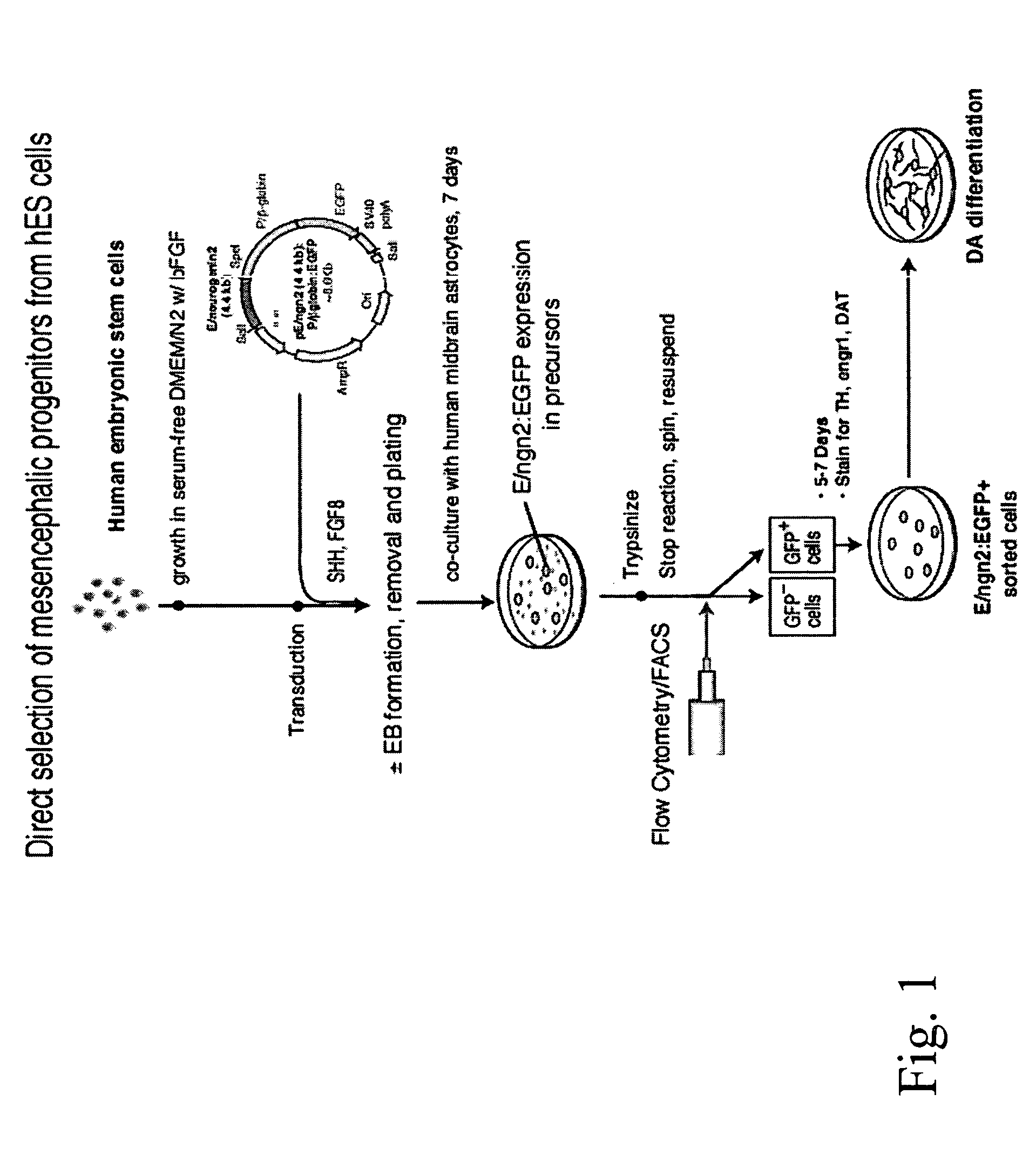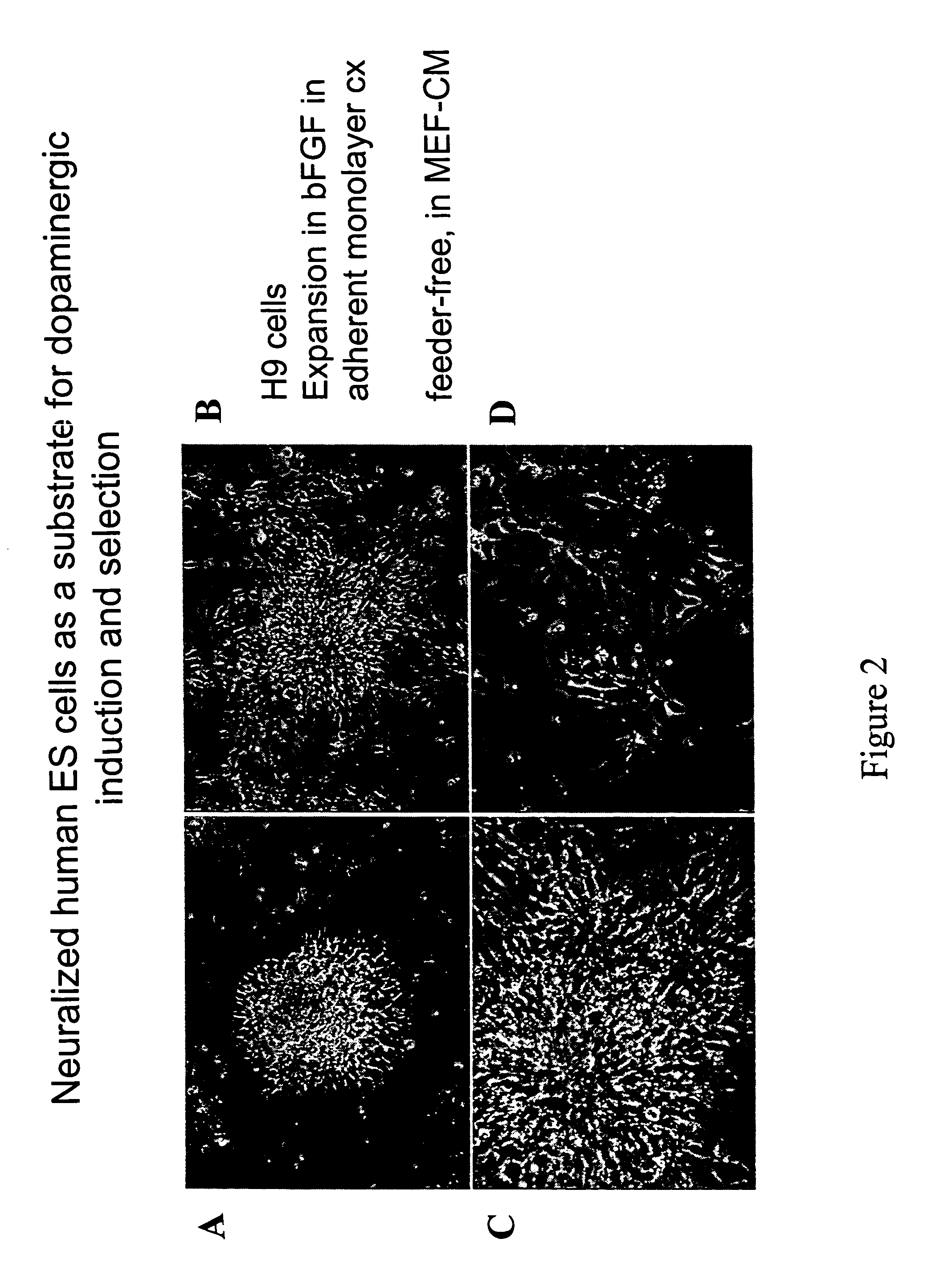Induction and high-yield preparative purification of mesencephalic dopaminergic neuronal progenitor cells and dopaminergic neurons from human embryonic stem cells
a technology of human embryonic stem cells and dopaminergic neurons, which is applied in the field of enrichment or purification of dopaminergic neuronal progenitor cells, an enrichment or purification population of dopaminergic neurons, can solve the problems of insufficient enrichment of dopaminergic neurons, and achieve the reduction of da levels, reduce the level of da, and improve the effect of motor behavior
- Summary
- Abstract
- Description
- Claims
- Application Information
AI Technical Summary
Benefits of technology
Problems solved by technology
Method used
Image
Examples
example 1
hES Culture
[0057] H9 hES cells (obtained from Geron Corp; CA) were cultured on matrigel coated (Becton and Dickinson, USA) plates. The cells were fed every day with FGF-2 (4 ng / ml; Invitrogen, USA) supplement conditioned medium obtained from irradiated mouse embryonic feeder cells (MEFs). The hES cells were passed every 7-14 days or when they were 80% confluent. At each pass, the cells were treated with collagenase type IV (200 U / ml; Invitrogen, USA) for 10 min, and gently scraped from the culture dish. The cells were then split 1:3-1:4, onto Matrigel-coated 6 well plates. The cells were fed every 24 hr with KO-DMEM (Invitrogen) supplemented with 20% KO-Serum replacement (KO-medium), and bFGF (4 ng / ml; Invitrogen). MEF cells were prepared as follows: fibroblasts obtained from E14 mouse embryos were grown to confluency in gelatin (0.1% W / V) coated flasks in DMEM supplemented with 10% fetal bovine serum (FBS; HyClone, USA). The cells were collected by treatment with trypsin / EDTA (Inv...
example 2
Induction and Differentiation of DA Neurons
[0058] Dopaminergic (“DA”) neurons were induced from hES cells using a protocol modified from McKay, Studer, and colleagues (Lee et al., “Efficient Generation of Midbrain and Hindbrain Neurons From Mouse Embryonic Stem Cells,”Nature Biotechnol 18-675-679 (2000); Pernier et al. “Derivation of Midbrain Dopamine Neurons From Human Embryonic Stem Cells,”Proc Natl Acad Sci USA 101:12543-12548 (2004), which are hereby incorporated by reference in their entirety) (FIG. 2A). Briefly, at 80% confluency, hES cell cultures were dissociated to form embryoid bodies (“EBs”). EBs were generated by scraping collagenase-treated hES cells and suspending them in Ultralow cluster 6 well plates (Corning, USA) in KO-medium without FGF2 for 4 days. EBs thus obtained were mechanically triturated and plated on tissue culture dishes in serum-free media supplemented with insulin / transferrin / selenite and fibronectin (ITSF medium), as described in Okabe et al., “Devel...
example 3
Generation of Immortalized hTERT-Overexpressing Astrocyte Lines
[0061] Midbrain or cortical tissues were dissected out from human 22 week gestational brains in Ca2+ / Mg2+-free Hanks Balanced Salt Solution (“HBSS”). The tissue was dissociated as per established protocols (Roy et al., “Telomerase Immortalization of Neuronally Restricted Progenitor Cells Derived from the Human Fetal Spinal Cord,”Nature Biotechnology 22:297-30 (2004), which is hereby incorporated by reference in its entirety). In short, dissected tissue was minced, suspended in PIPES buffer (in mM: 120 NaCl, 5 KCl, 25 glucose, and 20 PIPES), then digested in papain-PIPES (11.4 U / ml papain; Worthington, Freehold, N.J.) and DNase I (10 U / ml; Sigma, St. Louis, Mo.) for 40 min at 37° C. The tissue was collected by centrifugation and resuspended in DMEM / F-12 supplemented with N1 (Sigma, USA) in the presence of DNase I and reincubated for 15-30 min at 37° C. The tissue was finally dissociated by sequentially triturating 20, 10...
PUM
| Property | Measurement | Unit |
|---|---|---|
| Fraction | aaaaa | aaaaa |
| Fraction | aaaaa | aaaaa |
| Fluorescence | aaaaa | aaaaa |
Abstract
Description
Claims
Application Information
 Login to View More
Login to View More - R&D
- Intellectual Property
- Life Sciences
- Materials
- Tech Scout
- Unparalleled Data Quality
- Higher Quality Content
- 60% Fewer Hallucinations
Browse by: Latest US Patents, China's latest patents, Technical Efficacy Thesaurus, Application Domain, Technology Topic, Popular Technical Reports.
© 2025 PatSnap. All rights reserved.Legal|Privacy policy|Modern Slavery Act Transparency Statement|Sitemap|About US| Contact US: help@patsnap.com



